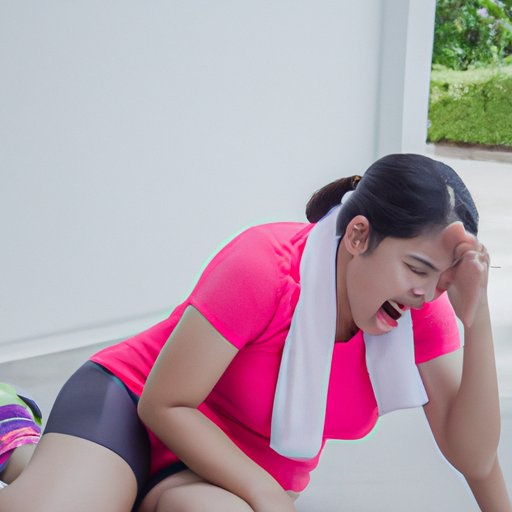Introduction
Menstruation is a natural part of life for women, occurring every month as part of the reproductive cycle. It can be uncomfortable and disruptive, but it doesn’t have to limit you from living an active lifestyle. Exercise during periods has many benefits, such as reducing cramps, improving mood, and boosting energy levels. This guide provides you with a comprehensive overview of exercising during menstruation, including the benefits, types of exercise, and tips for staying active.
A Comprehensive Guide to Exercising During Menstruation
Benefits of Exercising During Menstruation
Exercising during your period can help reduce premenstrual symptoms such as bloating, cramping, fatigue, and mood swings. It can also improve your overall mental health by reducing stress and anxiety. Regular physical activity can also help regulate your menstrual cycle, making it more regular and less painful. Additionally, exercise releases endorphins in your brain, which are known to improve your mood and make you feel happier.
What Types of Exercise are Best During Menstruation?
The type of exercise you choose should be based on your individual needs. Generally speaking, low-impact activities such as yoga, Pilates, walking, swimming, or biking are best during your period because they are gentle on your body and require less energy. You may also want to avoid high-impact activities such as running, jumping, or weightlifting, as these can be too intense for your body during this time. You should also be mindful not to overheat your body, as this can increase discomfort and worsen PMS symptoms.
How to Incorporate Exercise into Your Menstrual Cycle
It is important to listen to your body and adjust your exercise routine accordingly. If you are feeling particularly tired or sore during your period, it is okay to take a break from your usual workout and try something gentler. You may also want to incorporate more restorative practices such as yoga or light stretching into your routine. Additionally, you can use your menstrual cycle as an opportunity to experiment with different types of exercise and find what works best for you.

What to Avoid When Exercising During Menstruation
Intensity Levels
It is important to be aware of your intensity levels when exercising during your period. Your body is already working hard to manage the hormonal changes that occur during this time, so it is important to respect its limits. Overdoing it can lead to fatigue, cramping, and other unpleasant symptoms. It is best to stick to low-intensity activities and focus on taking it easy.
High-Impact Exercises
High-impact exercises such as running, jumping, or weightlifting can be too intense for your body during your period. These activities put additional strain on your body, which can cause cramping, fatigue, and other unpleasant symptoms. Stick to low-impact activities such as walking, swimming, or biking for a gentler workout.
Overheating
It is important to pay attention to how your body is feeling when exercising during your period. Overheating can increase discomfort and worsen PMS symptoms, so it is important to stay cool and hydrated. Avoid hot yoga classes and steam rooms, and opt for lighter activities such as walking or swimming instead.

Tips for Staying Active During Menstruation
Low-Intensity Workouts
Low-intensity workouts such as walking, swimming, or biking are great options for exercising during your period. These activities are gentle on your body and require less energy, making them perfect for managing premenstrual symptoms. Additionally, they can help regulate your menstrual cycle and boost your overall mood.
Focus on Breath and Movement
Breathwork and movement-based practices such as yoga and Pilates can be incredibly beneficial for your body during your period. These activities focus on connecting your breath with your movement, allowing you to move through any discomfort with more ease and grace. Additionally, they can help improve your posture and reduce stress and anxiety.
Listen to Your Body
It is important to listen to your body and adjust your exercise routine accordingly. If you are feeling particularly tired or sore during your period, it is okay to take a break from your usual workout and try something gentler. Additionally, if you are experiencing severe cramping or pain, it is best to take a few days off from exercise and allow your body to rest and recover.

How to Make the Most Out of Your Workout During Menstruation
Choose the Right Exercise
When exercising during your period, it is important to choose the right type of exercise for your body. Stick to low-impact activities such as walking, swimming, or biking for a gentler workout. Additionally, you may want to incorporate more restorative practices such as yoga or light stretching into your routine.
Set Realistic Goals
It is important to set realistic goals when exercising during your period. Your body is already working hard to manage the hormonal changes that occur during this time, so it is important to respect its limits. Aim to maintain your current fitness level rather than trying to push yourself too hard.
Track Your Progress
Tracking your progress can help you stay motivated and focused on your goals. Keep a journal of your workouts and note how you felt before, during, and after each session. This will help you recognize patterns and understand how your body responds to different types of exercise.
Conclusion
Exercising during your period can help reduce premenstrual symptoms such as bloating, cramping, fatigue, and mood swings. It is important to choose the right type of exercise for your body and set realistic goals. Low-impact activities such as walking, swimming, or biking are generally best during your period, and incorporating more restorative practices such as yoga or light stretching can help alleviate discomfort. Lastly, it is important to listen to your body and adjust your exercise routine accordingly.
(Note: Is this article not meeting your expectations? Do you have knowledge or insights to share? Unlock new opportunities and expand your reach by joining our authors team. Click Registration to join us and share your expertise with our readers.)
